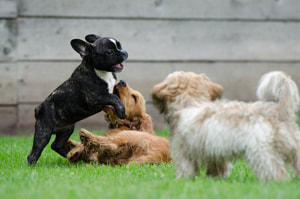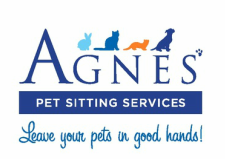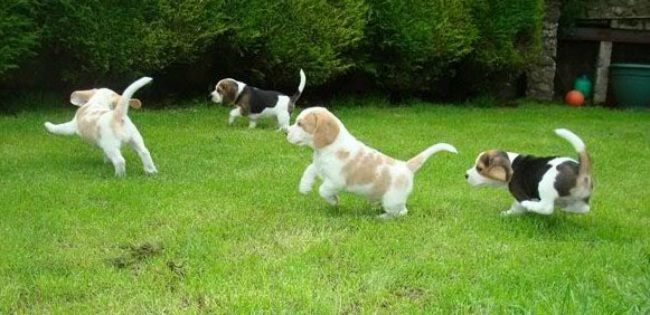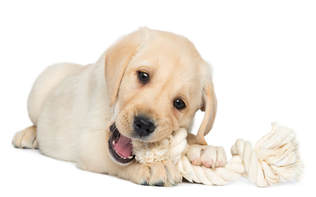
Socialization is the process of introducing a puppy to the world in a way that will help her be confident and unafraid of people, places and things that she will encounter throughout her life. The most critical socialization window occurs before the age of 12 weeks, and that window is considered to be closing by 5 months. Generally, the younger the puppy is when she is socialized, the more quickly and easily she gains confidence. Waiting too long can result in a need for the more difficult process of rehabilitation instead of socialization. Most aggression issues are simply a result of inefficient socialization.
Sometimes people overlook this fact but clearly one of the most important things that you can do for your puppy is to socialize her. Exposing her appropriately to as much as you can during this critical period will help to discover the world and help her cope with life as your companion and family member.
Socialization means to give your puppy careful, planned, positive exposure to everything that she may encounter as an adult dog. If she is exposed to a variety of people, dogs, places, smells, textures, etc., as a young pup, she is more likely to be friendly and confident as an adult! Please keep in mind that socialization must be done correctly, otherwise you may cause more harm than good.
When do you start? How about now! It is essential to make wise use of your time during the puppy’s canine and human socialization critical periods, but make sure socialization doesn’t stop there. It is not enough to have your puppy exposed to the world for the first couple of weeks, and then relegate him to the life of a recluse. Social interactions continue to be especially important throughout the first year of a dog’s life. After your dog’s first birthday, she should still have the opportunity to socialize.
Take your puppy to a range of new places: visiting neighbours, petfood shops, car rides, friends’ homes, and walks through the neighbourhood at a quiet time are all a good place to start. Exposing your puppy to new places can make her more flexible about changes when she is an adult (including being able to cope when you leave her with the pet sitter so that you can go on that dream vacation you have been saving for!). Keep these trips short and positive. Try places with minimal noise and activity, as this will help set your dog up for success by eliminating some of the fear factors.
How do you properly socialize? Keep in mind that you are teaching your puppy to be comfortable and enjoy new places, textures, dogs and people. This means that it is your responsibility to ensure that she is not overwhelmed by the situation.
Limit new people (adults or children) to 1-2 at a time, and make sure they are calm. Avoid letting people loom over the puppy or pick her up (both of which can be pretty scary to a puppy). Children sound, act, and move differently than adults. Be selective in choosing the first children your puppy meets. If your puppy is showing stress signs at any time, have the person stop where they are and let the puppy approach.
When socializing with dogs, avoid throwing your puppy into the lion’s den. These interactions should be well controlled because being mobbed by one or more dogs is not socialization. It is potentially traumatic. Begin by socializing your puppy with one or two other dogs at a time. Gradually increase the number when you are confident in the dogs’ social skills. Avoid busy dog parks where groups of dogs of varying ages and sizes are just thrown together. Also note that even if your puppy is growing up in a home with other dogs, she still needs to be socialized with unfamiliar dogs. She needs to learn how to greet and interact with dogs that she does not know so she can learn all of the canine rules of meeting a new dog. She should meet varying breeds and sizes. These experiences should always be with dogs that are friendly so that you set your puppy up for positive experiences.
As a good start you might take your pup for Puppy Parties. Puppy parties should only be run for puppies the same age, that is from approx. 8 weeks to 12 weeks and where they can play off leash. We offer Puppy play sessions with a reward-based trainer. To help out busy owners during this crucial stage we offer Train-n-play Extensive Socialization Sessions (TESS). Socialization sessions last up to 3 hours and including pick up and drop off.
General tips:
Each socialization unit should be fun for your puppy. You should not force your pup to confront her fears. She should definitely be allowed to retreat if she doesn’t feel safe. Try not to be excited yourself and radiate calmness. Your puppy will learn that she can count on you to be its safe haven.
Give treats freely to create positive associations. Treats can help your puppy to refocus (and not be fixated on her fear). If your pup is too nervous to take any treats it’s a sign for you to back off a little and slow down.
Help your puppy to generalize: Exposing your puppy to children only at home is not a guarantee that she's not afraid of children on a playground, or in the streets. Dogs are bad at generalization, so try to provide her with the most diverse experiences. Be sure to keep it positive and rather don’t risk a negative experience!
Go slowly: If your puppy goes nuts when seeing a brush, don’t try to brush her with it just yet. Let her get accustomed to the brush being in her vicinity and take it a step further when she’s relaxed around it.
Sometimes people overlook this fact but clearly one of the most important things that you can do for your puppy is to socialize her. Exposing her appropriately to as much as you can during this critical period will help to discover the world and help her cope with life as your companion and family member.
Socialization means to give your puppy careful, planned, positive exposure to everything that she may encounter as an adult dog. If she is exposed to a variety of people, dogs, places, smells, textures, etc., as a young pup, she is more likely to be friendly and confident as an adult! Please keep in mind that socialization must be done correctly, otherwise you may cause more harm than good.
When do you start? How about now! It is essential to make wise use of your time during the puppy’s canine and human socialization critical periods, but make sure socialization doesn’t stop there. It is not enough to have your puppy exposed to the world for the first couple of weeks, and then relegate him to the life of a recluse. Social interactions continue to be especially important throughout the first year of a dog’s life. After your dog’s first birthday, she should still have the opportunity to socialize.
Take your puppy to a range of new places: visiting neighbours, petfood shops, car rides, friends’ homes, and walks through the neighbourhood at a quiet time are all a good place to start. Exposing your puppy to new places can make her more flexible about changes when she is an adult (including being able to cope when you leave her with the pet sitter so that you can go on that dream vacation you have been saving for!). Keep these trips short and positive. Try places with minimal noise and activity, as this will help set your dog up for success by eliminating some of the fear factors.
How do you properly socialize? Keep in mind that you are teaching your puppy to be comfortable and enjoy new places, textures, dogs and people. This means that it is your responsibility to ensure that she is not overwhelmed by the situation.
Limit new people (adults or children) to 1-2 at a time, and make sure they are calm. Avoid letting people loom over the puppy or pick her up (both of which can be pretty scary to a puppy). Children sound, act, and move differently than adults. Be selective in choosing the first children your puppy meets. If your puppy is showing stress signs at any time, have the person stop where they are and let the puppy approach.
When socializing with dogs, avoid throwing your puppy into the lion’s den. These interactions should be well controlled because being mobbed by one or more dogs is not socialization. It is potentially traumatic. Begin by socializing your puppy with one or two other dogs at a time. Gradually increase the number when you are confident in the dogs’ social skills. Avoid busy dog parks where groups of dogs of varying ages and sizes are just thrown together. Also note that even if your puppy is growing up in a home with other dogs, she still needs to be socialized with unfamiliar dogs. She needs to learn how to greet and interact with dogs that she does not know so she can learn all of the canine rules of meeting a new dog. She should meet varying breeds and sizes. These experiences should always be with dogs that are friendly so that you set your puppy up for positive experiences.
As a good start you might take your pup for Puppy Parties. Puppy parties should only be run for puppies the same age, that is from approx. 8 weeks to 12 weeks and where they can play off leash. We offer Puppy play sessions with a reward-based trainer. To help out busy owners during this crucial stage we offer Train-n-play Extensive Socialization Sessions (TESS). Socialization sessions last up to 3 hours and including pick up and drop off.
General tips:
Each socialization unit should be fun for your puppy. You should not force your pup to confront her fears. She should definitely be allowed to retreat if she doesn’t feel safe. Try not to be excited yourself and radiate calmness. Your puppy will learn that she can count on you to be its safe haven.
Give treats freely to create positive associations. Treats can help your puppy to refocus (and not be fixated on her fear). If your pup is too nervous to take any treats it’s a sign for you to back off a little and slow down.
Help your puppy to generalize: Exposing your puppy to children only at home is not a guarantee that she's not afraid of children on a playground, or in the streets. Dogs are bad at generalization, so try to provide her with the most diverse experiences. Be sure to keep it positive and rather don’t risk a negative experience!
Go slowly: If your puppy goes nuts when seeing a brush, don’t try to brush her with it just yet. Let her get accustomed to the brush being in her vicinity and take it a step further when she’s relaxed around it.



 RSS Feed
RSS Feed